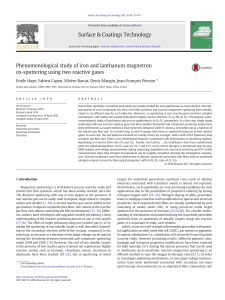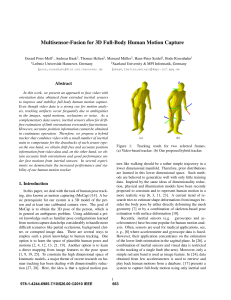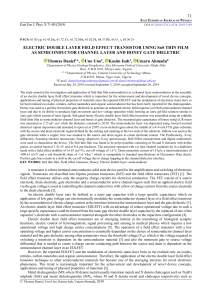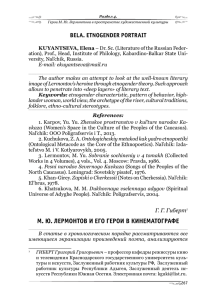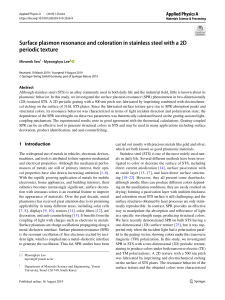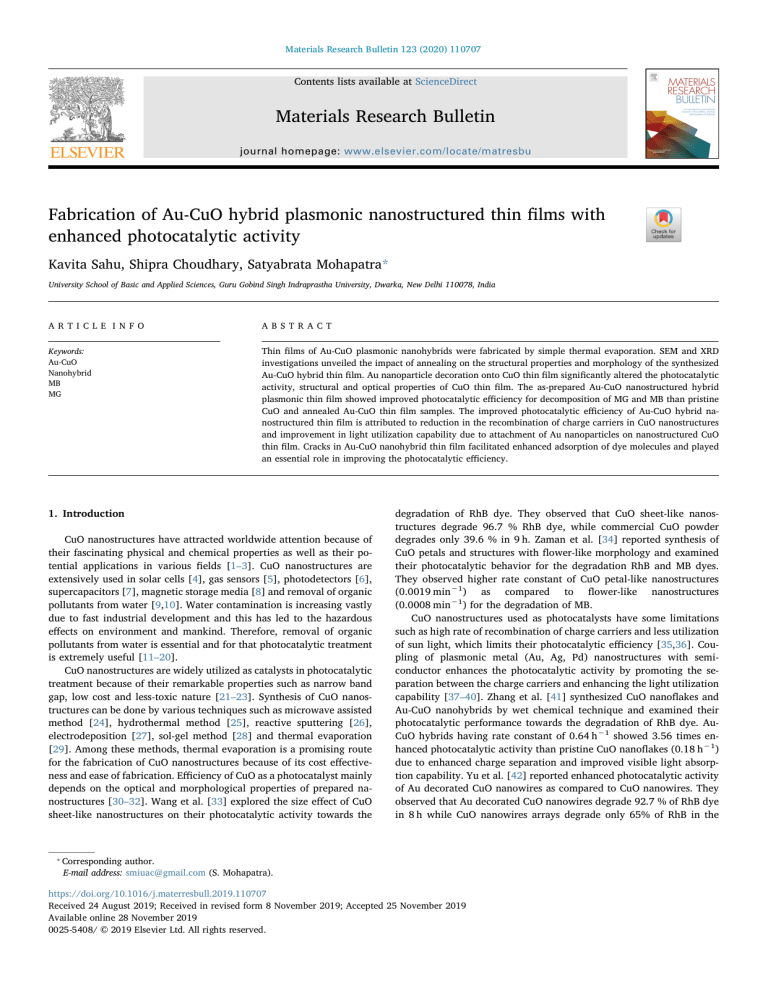
Materials Research Bulletin 123 (2020) 110707 Contents lists available at ScienceDirect Materials Research Bulletin journal homepage: www.elsevier.com/locate/matresbu Fabrication of Au-CuO hybrid plasmonic nanostructured thin films with enhanced photocatalytic activity T Kavita Sahu, Shipra Choudhary, Satyabrata Mohapatra* University School of Basic and Applied Sciences, Guru Gobind Singh Indraprastha University, Dwarka, New Delhi 110078, India A R T I C LE I N FO A B S T R A C T Keywords: Au-CuO Nanohybrid MB MG Thin films of Au-CuO plasmonic nanohybrids were fabricated by simple thermal evaporation. SEM and XRD investigations unveiled the impact of annealing on the structural properties and morphology of the synthesized Au-CuO hybrid thin film. Au nanoparticle decoration onto CuO thin film significantly altered the photocatalytic activity, structural and optical properties of CuO thin film. The as-prepared Au-CuO nanostructured hybrid plasmonic thin film showed improved photocatalytic efficiency for decomposition of MG and MB than pristine CuO and annealed Au-CuO thin film samples. The improved photocatalytic efficiency of Au-CuO hybrid nanostructured thin film is attributed to reduction in the recombination of charge carriers in CuO nanostructures and improvement in light utilization capability due to attachment of Au nanoparticles on nanostructured CuO thin film. Cracks in Au-CuO nanohybrid thin film facilitated enhanced adsorption of dye molecules and played an essential role in improving the photocatalytic efficiency. 1. Introduction CuO nanostructures have attracted worldwide attention because of their fascinating physical and chemical properties as well as their potential applications in various fields [1–3]. CuO nanostructures are extensively used in solar cells [4], gas sensors [5], photodetectors [6], supercapacitors [7], magnetic storage media [8] and removal of organic pollutants from water [9,10]. Water contamination is increasing vastly due to fast industrial development and this has led to the hazardous effects on environment and mankind. Therefore, removal of organic pollutants from water is essential and for that photocatalytic treatment is extremely useful [11–20]. CuO nanostructures are widely utilized as catalysts in photocatalytic treatment because of their remarkable properties such as narrow band gap, low cost and less-toxic nature [21–23]. Synthesis of CuO nanostructures can be done by various techniques such as microwave assisted method [24], hydrothermal method [25], reactive sputtering [26], electrodeposition [27], sol-gel method [28] and thermal evaporation [29]. Among these methods, thermal evaporation is a promising route for the fabrication of CuO nanostructures because of its cost effectiveness and ease of fabrication. Efficiency of CuO as a photocatalyst mainly depends on the optical and morphological properties of prepared nanostructures [30–32]. Wang et al. [33] explored the size effect of CuO sheet-like nanostructures on their photocatalytic activity towards the ⁎ degradation of RhB dye. They observed that CuO sheet-like nanostructures degrade 96.7 % RhB dye, while commercial CuO powder degrades only 39.6 % in 9 h. Zaman et al. [34] reported synthesis of CuO petals and structures with flower-like morphology and examined their photocatalytic behavior for the degradation RhB and MB dyes. They observed higher rate constant of CuO petal-like nanostructures (0.0019 min−1) as compared to flower-like nanostructures (0.0008 min−1) for the degradation of MB. CuO nanostructures used as photocatalysts have some limitations such as high rate of recombination of charge carriers and less utilization of sun light, which limits their photocatalytic efficiency [35,36]. Coupling of plasmonic metal (Au, Ag, Pd) nanostructures with semiconductor enhances the photocatalytic activity by promoting the separation between the charge carriers and enhancing the light utilization capability [37–40]. Zhang et al. [41] synthesized CuO nanoflakes and Au-CuO nanohybrids by wet chemical technique and examined their photocatalytic performance towards the degradation of RhB dye. AuCuO hybrids having rate constant of 0.64 h−1 showed 3.56 times enhanced photocatalytic activity than pristine CuO nanoflakes (0.18 h−1) due to enhanced charge separation and improved visible light absorption capability. Yu et al. [42] reported enhanced photocatalytic activity of Au decorated CuO nanowires as compared to CuO nanowires. They observed that Au decorated CuO nanowires degrade 92.7 % of RhB dye in 8 h while CuO nanowires arrays degrade only 65% of RhB in the Corresponding author. E-mail address: [email protected] (S. Mohapatra). https://doi.org/10.1016/j.materresbull.2019.110707 Received 24 August 2019; Received in revised form 8 November 2019; Accepted 25 November 2019 Available online 28 November 2019 0025-5408/ © 2019 Elsevier Ltd. All rights reserved. Materials Research Bulletin 123 (2020) 110707 K. Sahu, et al. Fig. 1. (a–d) SEM images of Au-CuO thin film samples CP, CAuP, CAu400 and CAu500. properties and thereby significantly improving its photocatalytic behavior for removal of organic pollutants from water. Photocatalytic action of the fabricated Au-CuO nanohybrid thin films under illumination with natural sun light and visible light from He-Ne laser was investigated. Au-CuO hybrid plasmonic nanostructures without annealing exhibited superior sun light and visible light active photocatalytic activities than pristine CuO and annealed Au-CuO nanostructured thin film samples and led to decomposition of MG and MB. Au-CuO nanostructured thin film exhibited extremely enhanced photocatalytic activities than CuO thin films reported in the literature. The mechanism underlying the improved activity of Au-CuO nanohybrid photocatalyst film was tentatively proposed. The present work focuses on the development of nanostructured Au-CuO hybrid thin films as emerging highly efficient and reusable photocatalysts for wastewater treatment. 2. Experimental details Fig. 2. XRD patterns of prepared thin film of CuO and Au-CuO hybrid thin films. Au-CuO hybrid plasmonic thin films were deposited onto silica glass substrates by thermal evaporation. In the first step, thermal evaporation of Cu on silica glass substrates followed by ageing in oxidizing ambient for 30 days led to the formation of CuO thin film,while in the second step Au thin film (5 nm) was deposited onto prepared CuO thin films using thermal evaporation of Au. Au deposited CuO thin film was further annealed at two different temperatures (400⁰C and 500⁰C) for 2 h in Ar atmosphere. Pristine thin film of CuO is hereafter referred as CP and Au-CuO hybrid plasmonic nanostructures without annealing and annealed at 400⁰C and 500⁰C are mentioned as CAuP, CAu400 and CAu500, respectively. X-ray diffraction (XRD) analysis employing Panalytical X’pert Pro diffractometer with Cu Kα radiation (λ =0.154 nm) was employed to analyze the crystal structure of the prepared thin films. Scanning electron microscopy (SEM, ZEISS) was carried out to examine the morphology of the Au-CuO hybrid plasmonic thin films. Chemical state of the Au-CuO thin film was analyzed using XPS (Omicron nanotechnology, Oxford instruments) with Al Kα of same exposure time. However, in practical scenario these reported nanomaterials in powder form suffer from some limitations as photocatalysts due to difficulty in separation, recovery and recyclability. These issues can be conquered by using photocatalysts in the form of thin films instead of powder since thin film photocatalysts can be used repeatedly without any complex recycling process. In view of this, we have fabricated a highly efficient reusable AuCuO nanohybrid thin film photocatalyst for the removal of organic dyes by a very simple and cost-effective technique. Au-CuO plasmonic hybrid nanostructured thin films consisting of Au nanoparticles and CuO nanostructures were fabricated by simple thermal evaporation method combined with annealing. Decoration of Au nanoparticles onto nanostructured CuO thin film was found to appreciably alter its optical 2 Materials Research Bulletin 123 (2020) 110707 K. Sahu, et al. Fig. 3. XPS spectra of (a) Cu 2p, (b) O 1s and (c) Au 4f from Au-CuO hybrid thin film. Fig. 4. Schematic possible growth mechanism of Au-CuO hybrid nanostructures. In this study, Au-CuO hybrid plasmonic thin films were dipped in 5 mL aqueous solutions of 5 μM of organic dyes (MB and MG) in glass vials separately. Decomposition of MG and MB dyes in the presence of thin film of Au-CuO hybrid photocatalysts was monitored for 30, 60 and 90 min of sunlight exposure. After sunlight exposure, UV–vis spectroscopy was used to study the photocatalytic activity of plasmonic AuCuO hybrid thin films for the removal of dyes. The efficiency of Au-CuO hybrid plasmonic thin films for photocatalytic degradation of dyes was estimated using the following relation. energy 1486.7 eV. Optical studies and photocatalytic behavior of AuCuO hybrid plasmonic thin films were explored with the help of UV–vis spectroscopy (HITACHI U-3300). 2.1. Photocatalytic studies In order to investigate the photocatalytic behavior of the prepared Au-CuO hybrid plasmonic thin films towards degradation of organic dyes under sunlight exposure, we used Au-CuO thin films as photocatalysts and MB and MG dyes as representative organic contaminants. 3 Materials Research Bulletin 123 (2020) 110707 K. Sahu, et al. face centered cubic phase of Au. It was observed that the intensity of (111) peak of Au increased along with its narrowing with the increase in annealing temperature. This signifies the growth of Au nanostructures due to annealing, which affects the morphology of prepared Au-CuO hybrid plasmonic nanostructures. The average crystallite sizes of Au nanoparticles in samples CAuP, CAu400 and CAu500 were found to be 11, 15 and 17 nm, respectively. XPS analysis was employed to examine the surface chemical state of Au-CuO hybrid thin film and the results are shown in Fig. 3. XPS signals of Cu 2p region in Au-CuO hybrid nanostructures are shown in Fig. 3(a). Two main peaks found at 932.8 and 952.7 eV are allocated to Cu 2p3/2 and Cu 2p1/2 of CuO, respectively. Fig. 3(b) shows the O 1s spectra of the prepared Au-CuO hybrid nanostructured thin film. Observed peaks at 530.5 and 532.4 eV are allocated to the O2− and oxygen adsorbed on CuO surface. Fig. 3(c) depicts the Au 4f XPS spectrum of Au-CuO hybrid thin film. Observed peaks at 84.2 and 87.9 eV are allocated to the core levels of Au 4f7/2 and Au 4f5/2, respectively and are assigned to Au(0) in the prepared Au-CuO hybrid nanostructures [43–46]. Mechanism underlying growth of AuCuO hybrid thin film is revealed in Fig. 4. Thermal evaporation of Au onto nanostructured CuO thin film with cracks leads to deposition of Au atoms on the surface of CuO nanostructures. Adsorption of impinging Au atoms on the CuO surface and their surface diffusion leads to the nucleation of Au nanoclusters and their growth into Au nanoparticles. Annealing results in growth of Au nanoparticles by conventional Ostwald ripening. Fig. 5. Optical absorption spectra of thin film of CuO and Au-CuO hybrid nanostructured thin films. η= C0 - C C0 (1) where C0 is the initial absorbance of dye (without catalyst) before sunlight illumination and C represents the absorbance of dye in the solution (with catalyst) after illumination. 3.2. Optical studies 2.1.1. In-situ capture experiment In this process, four different scavengers viz. TBA (tertiary-butyl alcohol), BQ (benzoquinone), FA (formic acid) and CN (cupric nitrate) were used as the representative scavenging chemicals for hydroxyl radicals (•OH ), superoxide radicals (•O2−), holes (h+ ) and electrons (e− ), respectively. 5 mM solutions of CN, FA and TBA and 0.5 mM of BQ were added into the photocatalytic systems to investigate the mechanism behind the photocatalytic activity of prepared Au-CuO hybrid thin films. Au-CuO hybrid thin film samples were immersed in different scavenger containing dye solutions and then illuminated to sunlight. Following thin film photocatalyst removal the solutions were analyzed using UV–vis absorption spectroscopy. 3. Results and discussion Fig. 5 presents the UV–vis absorbance spectra of samples CP, CAuP, CAu400 and CAu500. All the prepared samples show broad absorption band of CuO in the wavelength range from 300 to 500 nm. In addition to this peak, two broad absorption bands near 610 nm and 671 nm were observed in the CuO hybrid thin film. For Au-CuO thin film sample CAuP, one broad absorption band around 608 nm was observed. This absorption band changes into a very broad band blue shifted to 560 nm for the thin film sample annealed at 400 °C (sample CAu400). Further increase in annealing temperature to 500 °C (sample CAu500) resulted in a slight increase in the intensity of the absorption band red shifted to 606 nm. It shows the presence of Au nanoparticles and their aggregates in the prepared samples CAuP, CAu400 and CAu500. As seen from the absorbance data, Au decorated pristine CuO thin film without annealing (CAuP) shows higher absorbance than other samples. 3.1. Morphology and structural properties 3.3. Evaluation of photocatalytic activity Fig. 1(a–d) show the SEM images of prepared Au-CuO hybrid plasmonic thin film samples CP, CAuP, CAu400 and CAu500, respectively. Cracks in CuO and Au-CuO hybrid thin film were observed in samples CP and CAuP as shown in Fig. 1(a–b). As clearly seen from the SEM images, thermal annealing of Au-CuO hybrid plasmonic thin film led to increase in size of Au nanoparticles in Au-CuO hybrid thin film. The average size of Au nanoparticles in Au-CuO hybrid plasmonic thin film was estimated to be 46, 51 and 76 nm for the samples CAuP, CAu400 and CAu500, respectively. XRD was done to study the crystal structure of prepared CuO and Au-CuO thin films. Fig. 2 displays the XRD patterns of the prepared samples CP, CAuP, CAu400 and CAu500. XRD data clearly show the presence of peaks corresponding to CuO and Au in the samples CAuP, CAu400 and CAu500. XRD patterns of the prepared samples show monoclinic CuO and face centered cubic Au. XRD pattern of sample CP shows three peaks marked (1̄11), (1̄12) and (1̄13) which were well matched with the standard data (JCPDS 89–5895) of monoclinic phase of CuO. The XRD patterns of samples CAuP, CAu400 and CAu500 show peaks marked (1̄11), (1̄12) and (1̄13) , which were well matched with standard data (JCPDS 89–5895) of monoclinic phase of CuO whereas the peaks marked (111), (200), (220) and (311) matched well with the standard data (JCPDS 00-001-1172) of Fig. 6(a–d) presents the temporal variations in absorption spectra of MB dye with the synthesized thin film samples CP, CAuP, CAu400 and CAu500. It can be distinctly observed that Au-CuO hybrid plasmonic thin film without annealing (CAuP) shows enhanced photocatalytic performance over other samples. Au decorated CuO thin film without annealing degraded 84% of MB dye in 90 min. Kinetics of MB decomposition in the presence of Au-CuO hybrid plasmonic nanostructures are shown in Fig. 6(e). The efficiency of Au-CuO photocatalysts for decomposition of MB is shown as a function of exposure time in Fig. 6(f). Fig. 7(a–d) shows the temporal variations in the absorption spectra of MG with prepared thin film photocatalysts CP, CAuP, CAu400 and CAu500. Au-CuO hybrid plasmonic thin film without annealing (CAuP) shows enhanced photocatalytic activity as compared to other samples. Au decorated CuO sample (CAuP) degraded 85% of MG dye in 90 min. The degradation kinetics of MG in the presence of the synthesized photocatalysts are displayed in Fig. 7(e). The efficiency of Au-CuO photocatalysts for decomposition of MG is shown as a function of exposure time in Fig. 7(f). First order kinetics equation was used to determine the rate constants for decomposition of dyes C = C0 exp(−kt ) 4 (2) Materials Research Bulletin 123 (2020) 110707 K. Sahu, et al. Fig. 6. (a–d) Temporal variations in the absorption spectra of MB with photocatalysts. (e) Degradation kinetics of MB by thin film photocatalysts. (f) Efficiency of the synthesized thin film photocatalysts for the decomposition of MB. hybrid plasmonic thin film sample was found to degrade 72.3 % of MB dye in 2.5 h. Kinetics of MB decomposition in the presence of thin film photocatalysts are presented in Fig. 8(c). Efficiency of the prepared nanostructured CuO and Au-CuO hybrid plasmonic thin film photocatalysts for removal of MB are shown in Fig. 8(d). The enriched photocatalytic activity of the as-deposited Au-CuO plasmonic thin film can be easily understood as follows. When photon of energy hυ strikes nanostructured CuO surface, excitation of electrons takes place from the valence band to its conduction band leaving holes in the valence band (Eq. 3). Contact of the photogenerated holes with water and photogenerated electrons with oxygen leads to the formation of hydroxyl radicals and superoxide radicals, respectively (Eq. 4–6). Superoxide radicals and hydroxyl radicals react with organic dyes and degrade them into non-toxic compounds (equation 7 & 8). Photocatalytic where C0 denotes the starting concentration of dye (without catalyst), C denotes the concentration of dye with photocatalyst after sunlight exposure. The determined rate constants for MB degradation in the presence of thin film photocatalysts CP, CAuP, CAu400 and CAu500 are 0.008, 0.021, 0.014 and 0.016 min−1, respectively. The rate constant values for MG degradation in the presence of photocatalysts CP, CAuP, CAu400 and CAu500 are found to be 0.007, 0.160, 0.0159 and 0.0163 min−1, respectively. Photocatalytic activities of CuO and AuCuO hybrid thin film samples were also evaluated by degradation of MB under 632.8 nm visible light irradiation from He-Ne laser. Fig. 8(a–b) displays the temporal variations in the absorption spectra of MB with the synthesized thin film photocatalysts under 632.8 nm visible light exposure. Au-CuO hybrid plasmonic thin film showed highly enhanced photocatalytic activity as compared to pristine CuO thin film. Au-CuO 5 Materials Research Bulletin 123 (2020) 110707 K. Sahu, et al. Fig. 7. (a–c) Temporal variations in the absorption spectra of MG with photocatalysts. (e) Degradation kinetics of MG by the synthesized thin film photocatalysts. (f) Efficiency of the thin film photocatalysts for the decomposition of MG. of CuO to Au nanoparticles because of the difference in their Fermi energy levels. Fermi level of the Au-CuO nanohybrids is lower than the conduction band of CuO. Thus electron transfer from CuO nanostructures to Au nanoparticles enhances the separation between charge carriers by reducing their recombination rate. Fig. 9(a) shows the general schematic representation that describes the charge transportation in Au-CuO hybrid plasmonic nanostructures resulting in the decomposition of dye. decomposition of dye by CuO nanostructures is defined by the equations as shown below CuO + hυ → e− (C . B.) + h+ (V . B.) (3) h+ → •OH (4) •O2− (5) e− h+ + OH− + O2 → + H2 O → H+ + •OH (6) •OH + organic dye → degradation products (7) •O2− (8) + organic dye → degradation products 3.4. Role of active radicals Reactive species significantly contribute to the photocatalytic removal of organic pollutants. TBA, CN, BQ and FA act as representative In case of Au nanoparticle decorated CuO hybrid nanostructures, flow of photogenerated electrons takes place from the conduction band 6 Materials Research Bulletin 123 (2020) 110707 K. Sahu, et al. Fig. 8. (a–b) Temporal variations in the absorption spectra of MB with thin film photocatalysts under He-Ne laser exposure. (c) Degradation kinetics of MB by thin film photocatalysts. (d) Efficiency of the synthesized thin film photocatalysts for the decomposition of MB under He-Ne laser exposure. Fig. 9. (a) General schematic representation of possible mechanism of photocatalytic decomposition of dye by Au-CuO hybrid plasmonic nanostructure. (b) Efficiency of Au-CuO plasmonic thin film for photocatalytic removal of MB in the absence and presence of scavengers. (c) C/C0 versus illumination time results of MB decomposition for three runs in the presence of Au-CuO nanohybrid thin film. 7 Materials Research Bulletin 123 (2020) 110707 K. Sahu, et al. performance, higher surface area of the film because of cracks formed in CuO thin film leading to efficient adsorption of dye molecules and the smaller crystallite size of Au nanoparticles which helps in improving charge separation. Table 1 Comparative list showing the rate constants of catalysts towards the degradation of organic dye. Photocatalyst Rate constant (min−1) Reference CuO petal-like nanostructures CuO flower-like nanostructures Ag-CuO nanostructures CuO nanoflakes Au-CuO nanohybrid nanostructured thin film CuO thin film Au-CuO hybrid nanostructured thin film CuO thin film Au-CuO hybrid nanostructured thin film 0.0019 (MB) 0.0008 (MB) 0.0102 (MB) 0.003 (RhB) 0.0106 (RhB) Ref Ref Ref Ref Ref 0.008 0.021 0.007 0.160 This This This This (MB) (MB) (MG) (MG) 4. Conclusion 29 29 35 36 36 In summary, we have prepared Au-CuO plasmonic nanohybrid thin films by simple thermal evaporation. Visible light and sunlight driven photocatalytic activities of the prepared Au-CuO nanohybrid thin films were evaluated. Au-CuO hybrid plasmonic thin film without annealing showed superior photocatalytic activities over pristine CuO and annealed Au-CuO thin film samples and led to complete degradation of MG and MB in 90 min. UV–vis absorption studies showed that Au-CuO hybrid thin film without annealing has higher absorbance of light in the UV–vis region. Effective suppression of charge carriers in nanostructured CuO thin film and improvement in its light utilization capability upon Au nanoparticle decoration are the main factors leading to the enhanced photocatalytic behavior of Au-CuO plasmonic thin film. Superior photocatalytic performance and simple synthesis of hybrid nanostructured thin film of Au-CuO can enrich efficient material systems for the sunlight and visible light driven reusable photocatalysis towards efficient removal of organic pollutants. work work work work scavengers for hydroxyl radicals (%OH), photogenerated electrons (e−), superoxide radicals (•O2−) and photogenerated holes (h+), respectively. The efficiency of Au-CuO plasmonic thin film for photocatalytic removal of MB in the absence and presence of these scavengers for the same sunlight exposure conditions is shown in Fig. 9(b). Addition of BQ resulted in decrease in photocatalytic efficiency from 84.2%–79.1%, while the efficiency reduced to 68.2% with the addition of FA. This clearly indicates that •O2− and photogenerated electrons (e–) radicals play minor roles in the photocatalytic degradation process. The photocatalytic degradation efficiency of Au-CuO plasmonic thin film was reduced from 84.2%–59.3% when CN was added into the system. When TBA was added into the system, the photocatalytic degradation efficiency of Au-CuO plasmonic thin film was significantly inhibited (reduced from 84.2%–12.6%). This shows that %OH significantly affects the photocatalytic efficiency of the prepared Au-CuO plasmonic thin film. Hydroxyl radicals were observed to be the main active species accountable for the photocatalytic removal of MB in water by Au-CuO hybrid plasmonic thin film. Declaration of Competing Interest The authors declare that they have no known competing financial interests or personal relationships that could have appeared to influence the work reported in this paper. Acknowledgements This work is financially supported by Department of Science and Techonology (DST), New Delhi under WOS-A scheme (SR/WOS-A/ PM10/2017 (G&C)). The authors thank Dr. Rahul Singhal for the XPS studies. 3.5. Reusability of photocatalysts References The reusability of Au-CuO nanohybrids was examined for the decomposition of MB under the same reaction conditions. Fig. 9(c) shows the C/C0 versus illumination time results of MB decomposition for three runs in the presence of Au-CuO nanohybrids thin film. No significant change in the photocatalytic activity was observed even after three cycles which shows the reusability of the prepared Au-CuO hybrid plasmonic thin film photocatalysts towards the degradation of organic dyes in water. Decoration of Au nanoparticles onto nanostructured thin film of CuO significantly improves the absorption of visible light due to SPR effect as well as increases the separation of charge carriers [39]. Therefore photocatalytic activity for degradation of organic pollutants in water improved due to the interfaces between CuO and Au nanoparticles. Nanoparticle size, surface area and interface between metal and semiconductor nanostructures play crucial roles in determining the photocatalytic activity of hybrid plasmonic nanostructures. Comparative list of rate constants of nanostructures towards the degradation of organic dye is shown in Table 1. It can be clearly observed from the table that the prepared Au-CuO hybrid thin film has highly improved rate constant for the decomposition of organic dye as compared to the some earlier reported works. Zhang et al. [47] studied the catalytic behavior of CuO and CuO/Au nanostructures for CO conversion and observed that CuO/Au catalysts show superior catalytic activity than CuO due to the interface between Au and CuO. In our case also, Au nanoparticle decoration enhances the photocatalytic activity of CuO thin film for the decomposition of organic dyes in water. Au-CuO hybrid plasmonic thin film without annealing shows superior photocatalytic activity due to its higher sun light utilization capability than other samples which appreciably contributes to improved photocatalytic [1] Q. Zhang, K. Zhang, D. Xu, G. Yang, H. Huang, F. Nie, C. Liu, S. Yang, CuO nanostructures: synthesis, characterization, growth mechanisms, fundamental properties and applications, Prog. Mater. Sci. 60 (2014) 208–337. [2] M. Sabbaghan, A.S. Shahvelayati, K. Madankar, CuO nanostructures: optical properties and morphology control by pyridinium-based ionic liquids, Spectrochimica. Acta. Part A: Mol. Biomol. Spectrosc. 135 (2015) 662–668. [3] X. Zhang, G. Wang, X. Liu, J. Wu, M. Li, J. Gu, H. Liu, B. Fang, Different CuO nanostructures: synthesis, characterization, and applications for glucose sensors, J. Phys. Chem. C 112 (2008) 16845–16849. [4] S. Anandan, X. Wen, S. Yang, Room temperature growth of CuO nanorod arrays on copper and their application as a cathode in dye-sensitized solar cells, Mater. Chem. Phys. 93 (2005) 35–40. [5] H. Xu, G. Zhu, D. Zheng, C. Xi, X. Xu, X. Shen, Porous CuO superstructure: precursor-mediated fabrication, gas sensing and photocatalytic properties, J. Colloid Interface Sci. 383 (2012) 75–81. [6] Q. Hong, Y.Cao J. Xu, H. Lu, J. He, J.L. Sun, Self-powered ultrafast broadband photodetector based on p–n heterojunctions of CuO/Si nanowire array, ACS Appl. Mater. Interfaces 6 (2014) 20887–20894. [7] K. Krishnamoorthy, S.J. Kim, Growth, Characterization and electrochemical properties of hierarchical CuO nanostructures for supercapacitor applications, Mater. Res. Bull. 48 (2013) 3136–3139. [8] M.A. Dar, Q. Ahsanulhaq, Y.S. Kim, J.M. Sohn, W.B. Kim, H.S. Shin, Versatile synthesis of rectangular shaped nanobat-like CuO nanostructures by hydrothermal method; structural properties and growth mechanism, Appl. Surf. Sci. 255 (2009) 6279–6284. [9] K. Sahu, S. Choudhary, S.A. Khan, A. Pandey, S. Mohapatra, Thermal evolution of morphological, structural, optical and photocatalytic properties of CuO thin films, Nano-structures Nano-objects 17 (2019) 92–102. [10] L. Yang, D. Chu, L. Wang, CuO core-shell nanostructures: precursor-mediated fabrication and visible-light induced photocatalytic degradation of organic pollutants, Powder Technol. 287 (2016) 346–354. [11] A. Jamal, M.M. Rahman, S.B. Khan, M. Faisal, K. Akhtar, M.A. Rub, A.M. Asiri, A.O. Al-Youbi, Cobalt doped antimony oxide nano-particles based chemical sensor and photo-catalyst for environmental pollutants, Appl. Surf. Sci. 261 (2012) 52–58. [12] S. Kuriakose, B. Satpati, S. Mohapatra, Highly efficient photocatalytic degradation 8 Materials Research Bulletin 123 (2020) 110707 K. Sahu, et al. [13] [14] [15] [16] [17] [18] [19] [20] [21] [22] [23] [24] [25] [26] [27] [28] [29] [30] of organic dyes by Cu doped ZnO nanostructures, Phys. Chem. Chem. Phys. 17 (2015) 25172–25181. J. Low, J. Yu, M. Jaroniec, S. Wageh, A.A. Al‐Ghamdi, Heterojunction photocatalysts, Adv. Mater. 29 (2017) 1601694–1601714. K. Fan, Z. Jin, H. Yuan, H. Hu, Y. Bi, Construction of CuO-modified zeolitic imidazolate framework-9 for photocatalytic hydrogen evolution, Chin. J. Catal. 38 (2017) 2056–2066. S. Harish, J. Archana, M. Sabarinathan, M. Navaneethan, K.D. Nisha, S. Ponnusamy, C. Muthamizhchelvan, H. Ikeda, D.K. Aswal, Y. Hayakawa, Controlled structural and compositional characteristic of visible light active ZnO/CuO photocatalyst for the degradation of organic pollutant, Appl. Surf. Sci. 418 (2017) 103–112. G. Dong, B. Du, L. Liu, W. Zhang, Y. Liang, H. Shi, W. Wang, Synthesis and their enhanced photoelectrochemical performance of ZnO nanoparticle-loaded CuO dandelion heterostructures under solar light, Appl. Surf. Sci. 399 (2017) 86–94. D. Smazna, S. Shree, O. Polonskyi, S. Lamaka, M. Baum, M. Zheludkevich, F. Faupel, R. Adelung, Y.K. Mishra, Mutual interplay of ZnO micro-and nanowires and methylene blue during cyclic photocatalysis process, J. Environ. Chem. Eng. 7 (2019) 103016. J. Gröttrup, F. Schütt, D. Smazna, O. Lupan, R. Adelung, Y.K. Mishra, Porous ceramics based on hybrid inorganic tetrapodal networks for efficient photocatalysis and water purification, Ceram. Inter. 43 (2017) 14915–14922. Y.K. Mishra, R. Adelung, ZnO tetrapod materials for functional applications, Mater. Today 21 (2018) 631–651. S.J. Park, G.S. Das, F. Schütt, R. Adelung, Y.K. Mishra, K.M. Tripathi, T. Kim, Visible-light photocatalysis by carbon-nano-onion-functionalized ZnO tetrapods: degradation of 2, 4-dinitrophenol and a plant-model-based ecological assessment, NPG Asia Mater. 11 (2019) 8. X. Liu, Y. Cheng, X. Li, J. Dong, High-efficiency and conveniently recyclable photocatalysts for dye degradation based on urchin-like CuO microparticle/polymer hybrid composites, Appl. Surf. Sci. 439 (2018) 784–791. N. Sreeju, A. Rufus, D. Philip, Studies on catalytic degradation of organic pollutants and anti-bacterial property using biosynthesized CuO nanostructures, J. Molecular Liq. 242 (2017) 690–700. J. Zhu, X. Qian, From 2-D CuO nanosheets to 3-D hollow nanospheres: interfaceassisted synthesis, surface photovoltage properties and photocatalytic activity, J. Solid State Chem. 183 (2010) 1632–1639. L. Xu, H.Y. Xu, F. Wang, F.J. Zhang, Z.D. Meng, W. Zhao, O.H. WC, Microwaveassisted synthesis of flower-like and plate-like CuO nanopowder and their photocatalytic activity for polluted lake water, J. Korean Ceram. Soc. 49 (2012) 151–154. K. Kannaki, P.S. Ramesh, D. Geetha, Hydrothermal synthesis of CuO nanostructure and their characterizations, J. Sci. Eng. Res. 3 (2012) 1–4. P. Samarasekara, N.T. Kumara, N.U. Yapa, Sputtered copper oxide (CuO) thin films for gas sensor devices, J. Phys. Condens. Matter 18 (2006) 2417–2420. L. Chen, S. Shet, H. Tang, H. Wang, T. Deutsch, Y. Yan, J. Turner, M. Al-Jassim, Electrochemical deposition of copper oxide nanowires for photoelectrochemical applications, J. Mater. Chem. 20 (2010) 6962–6967. Z. Yang, J. Xu, W. Zhang, A. Liu, S. Tang, Controlled synthesis of CuO nanostructures by a simple solution route, J. Solid State Chem. 180 (2007) 1390–1396. R. Al-Gaashani, S. Radiman, N. Tabet, A.R. Daud, Synthesis and optical properties of CuO nanostructures obtained via a novel thermal decomposition method, J. Alloys. Compd. 509 (2011) 8761–8769. J. Liu, J. Jin, Z. Deng, S.Z. Huang, Z.Y. Hu, L. Wang, C. Wang, L.H. Chen, Y. Li, [31] [32] [33] [34] [35] [36] [37] [38] [39] [40] [41] [42] [43] [44] [45] [46] [47] 9 G.V. Tendeloo, B.L. Su, Tailoring CuO nanostructures for enhanced photocatalytic property, J. Colloid Interface Sci. 384 (2012) 1–9. Y. Li, X.Y. Yang, J. Rooke, V.G. Tendeloo, B.L. Su, Ultralong Cu(OH)2 and CuO nanowire bundles: PEG200-directed crystal growth for enhanced photocatalytic performance, J. Colloid Interface Sci. 348 (2010) 303–312. Y. Zhao, H. Shi, M. Chen, F. Teng, Splitting growth of novel CuO straw sheaves and their improved photocatalytic activity due to exposed active {110} facets and crystallinity, CrystEngComm 16 (2014) 2417–2423. L.J. Wang, Q. Zhou, Y. Liang, H. Shi, G. Zhang, B. Wang, W. Zhang, B. Lei, W.Z. Wang, Size effect and enhanced photocatalytic activity of CuO sheet-like nanostructures prepared by a room temperature solution phase chemical method, Appl. Surf. Sci. 271 (2013) 136–140. S. Zaman, A. Zainelabdin, G. Amin, O. Nur, M. Willander, Efficient catalytic effect of CuO nanostructures on the degradation of organic dyes, J. Phys. Chem. Solids 73 (2012) 1320–1325. M.M. Momeni, M. Mirhosseini, N. Mohammadi, Efficient photo catalytic degradation of methyl orange over Ag-CuO nanostructures grown on copper foil under visible light irradiation, J. Mater. Sci. Mater. Electron. 27 (2016) 6542–6551. P. Sathishkumar, R. Sweena, J.J. Wu, S. Anandan, Synthesis of CuO-ZnO nanophotocatalyst for visible light assisted degradation of a textile dye in aqueous solution, Chem. Eng. J. 171 (2011) 136–140. S. Kuriakose, K. Sahu, S.A. Khan, A. Tripathi, D.K. Avasthi, S. Mohapatra, Facile synthesis of Au-ZnO plasmonic nanohybrids for highly efficient photocatalytic degradation of methylene blue, Opt. Mater. 64 (2017) 47–52. S. Kuriakose, V. Choudhary, B. Satpati, S. Mohapatra, Facile synthesis of Ag-ZnO hybrid nanospindles for highly efficient photocatalytic degradation of methyl orange, Phys. Chem. Chem. Phys. 16 (2014) 17560–17568. W.M.A. El Rouby, A.A. Al-Ghamdi, M.S.A. Wahab, A. Jilani, Sunlight-enhanced catalytic degradation over Ag-CuO nanoparticles thin films prepared by DC/RF sputtering technique, Bull. Mater. Sci. 41 (2018) 58–69. J. Pal, M. Ganguly, S. Dutta, C. Mondal, Y. Negishi, T. Pal, Hierarchical Au-CuO nanocomposite from redox transformation reaction for surface enhanced Raman scattering and clock reaction, CrystEngComm 16 (2014) 883–893. X. Zhang, Y. Yang, W. Que, Y. Du, Synthesis of high quality CuO nanoflakes and CuO-Au nanohybrids for superior visible light photocatalytic behavior, RSC Adv. 6 (2016) 81607–81613. Y. Yu, Y. Zhao, H. Sun, M. Ahmad, Au nanoparticles decorated CuO nanowire arrays with enhanced photocatalytic properties, Mater. Lett. 108 (2013) 41–55. C.T. Hsieh, J.M. Chen, H.H. Lin, H.C. Shih, Field emission from various CuO nanostructures, Appl. Phys. Lett. 83 (2003) 3383–3385. L. Martin, H. Martinez, D. Poinot, B. Pecquenard, F. Le Cras, Comprehensive X-ray photoelectron spectroscopy study of the conversion reaction mechanism of CuO in lithiated thin film electrodes, J. Phys. Chem. C. 117 (2013) 4421–4430. Y. Li, W. Na, H. Wang, W. Gao, Hydrogenation of CO2 to methanol over Au–CuO/ SBA-15 catalysts, J. Porous Mater. 24 (2017) 591–599. J. Luo, Y. Liu, Y. Niu, Q. Jiang, R. Huang, B. Zhang, D. Su, Insight into the chemical adsorption properties of CO molecules supported on Au or Cu and hybridized Au–CuO nanoparticles, Nanoscale 9 (2017) 15033–15043. X. Zhang, G. Li, S. Yang, X. Song, Z. Sun, Nanoporous CuO ribbons modified by Au nanoparticles through chemical dealloying and calcination for CO oxidation, Microporous Mesoporous Mater. 226 (2016) 61–70.

